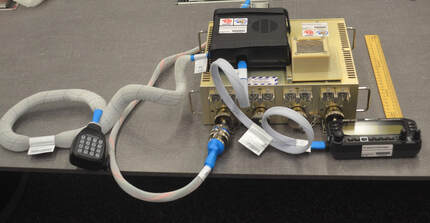During this Holiday Season, when the spirit of giving and receiving gifts reigns high, ARISS received a special gift and delivered a phenomenal gift to the international community. This occurred on Thursday December 19, 2019.
Our international gift to all—students, STEM education, the public and the amateur radio community—was the historic transfer of the first Interoperable Radio System (IORS) flight unit, serial number 1001, to NASA Johnson Space Center for launch on SpaceX CRS-20. The special gift received by ARISS was the approval from NASA Safety to launch the IORS on SpaceX CRS-20 and stow the radio system on the International Space Station. December 19, 2019 was truly a banner day for ARISS!
The IORS is a foundational element of the ARISS next generation radio system and is an incredible engineering achievement by the ARISS hardware team. This first element delivery will support easier radio mode transitions and enable new, exciting capabilities for hams, students and the general public. The IORS will include a higher power radio, an enhanced voice repeater, updated digital packet radio (APRS) capabilities and slow scan television (SSTV) capabilities for both the US and Russian segments. The IORS consists of a special, modified JVCKenwood TM-D710GA transceiver, an AMSAT-developed multi voltage power supply and interconnecting cables.
This first flight IORS will be installed in the ISS Columbus module. A second flight unit is expected to be launched sometime in 2020 for installation in the Russian Service module. A total of 4 flight units and 10 total units will be built by the ARISS hardware team to support on-board flight operations, training, operations planning and hardware testing. Future upgrades and enhancements to the next generation system are in various stages of design & development. These include a repaired Ham Video system (currently planned for launch in mid-to-late 2020), L-band (uplink) repeater, ground command operations capability, LimeSDR signal reception, a microwave “Ham Communicator” and Lunar Gateway prototype experiment.
While yesterday was truly an historic milestone, it should be noted that there is still much “heavy lifting” work to be done to prepare the IORS for Operations on ISS. ARISS has 92 engineering requirements and our operations Phase III safety review to complete. The space agencies take a position of “Trust but Verify.” Thus, these engineering and safety “verifications” all need to be closed out before the IORS can be unstowed and turned on. This will be the ARISS hardware team’s focus over the next few months.
Also, please remember that ARISS is almost entirely run by volunteers. So donations to the ARISS program for next generation hardware developments, operations, education and administrative functions are always welcome. Please go to https://www.ariss.org/donate.html if you want to contribute to our efforts!
In closing, ARISS would like to thank the outstanding contributions of the IORS hardware development team on an incredible radio system. ARISS would like to thank our sponsors and donors for helping us realize the IORS hardware systems. On behalf of the ARISS team, we would like to wish you all a joyful and prosperous Holiday Season—Merry Christmas, Happy Hanukkah, and Happy New Year!!
Ad Astra! To the Stars!
73,
Frank Bauer, KA3HDO
ARISS International Chair
AMSAT V.P. for Human Spaceflight Programs

